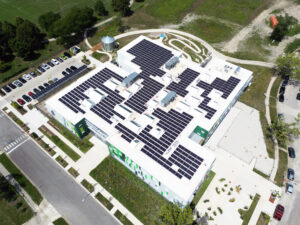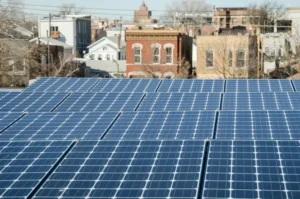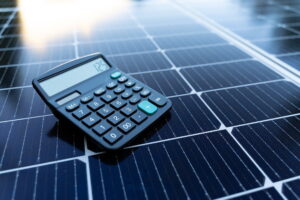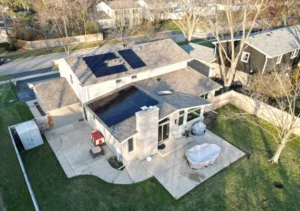It’s Bigger Than Your A/C. It’s a Broken System.
The easy answer is to blame the summer heatwaves, and sure, running the AC adds up. But that’s like blaming a puddle for a flood. The real reason your bill is skyrocketing is bigger, more complex, and frankly, more infuriating.
It’s a story about a broken system, hundreds of miles away, that’s been quietly rigging the game against your wallet.
And it’s time to introduce the players.
Meet PJM: The Secret Architect of Your High Electric Bill
You’ve probably never heard of PJM Interconnection, and that’s by design.
Think of them as the stock market for electricity, a massive, quasi-governmental organization that manages the wholesale power grid for 13 states, including all of Northern Illinois. Their stated job is to make sure there’s always enough power to go around, especially on the hottest days of the year.
To do this, they hold something called a “capacity auction.” It’s essentially a bidding process where power plant owners get paid today to guarantee they’ll be able to produce electricity three years in the future.
For years, this was a relatively boring, low-cost part of your bill.
Not anymore.
The Real Culprit Isn’t Your Thermostat. It’s Their Auction.
In the auction PJM held for the 2025-2026 year, something unprecedented happened. The price for that future power guarantee—what’s known as the “capacity price”—skyrocketed.
According to public auction results, the price for most of Illinois jumped from $28.92 to $269.92 per unit of power.
That’s an 830 percent increase. In a single year.
And here’s the kicker: that cost doesn’t just vanish into thin air. PJM and the grid operators pass it down, and it lands squarely on the “supply” portion of your ComEd bill—the exact part that shot up this summer.
The thermostat you nudged up a few degrees didn’t cause an 830% price spike. A backroom auction hundreds of miles away did.
But a price doesn’t jump that high by accident. It’s a symptom of a much deeper problem, a place where the system truly begins to show its cracks. In our next post, we’ll show you the absurd truth about how you’re being forced to pay twice for “zombie” power plants that are rigging the game against you.
So, the Game Is Rigged. Now What?
Let’s be honest. Learning that a faceless organization called PJM can jack up your energy supply costs by 830 percent through a complex auction is… infuriating.
It feels like you have two options: pay whatever they demand, or sit in the dark.
It’s a feeling of complete powerlessness. You can’t audit PJM. You can’t vote them out. You can’t stop the data centers from being built. You’re just one person at the end of a very long, very expensive wire.
So, when the entire game is rigged against you, what are you supposed to do?
You Don’t Fix the System. You Make It Irrelevant.
Here’s the secret: You stop playing their game.
You don’t have to accept the rigged auctions and the wild price swings as a fact of life. You can’t change PJM, but you can take away their power over your wallet.
You can choose to opt out.
This is where we have to reframe what “going solar” means. For decades, it’s been talked about as a green initiative, a science project for the eco-conscious. That’s true, but it misses the bigger picture.
In today’s world of volatile energy markets, generating your own power isn’t just an environmental choice. It’s a strategic, financial decision to declare your energy independence. It’s about taking the most unpredictable part of your household budget and putting it back under your control.
How Your Roof Becomes Your Personal Power Plant
This isn’t about turning your house into a science experiment. It’s much simpler than that.
Think of it this way: Right now, you rent 100% of your electricity from a single, unpredictable landlord (ComEd/PJM). They can change the terms and raise the rent whenever their own costs go up, and you have no choice but to pay.
Installing solar panels is like building a small, private power station on your own property—your roof.
- During the day, your panels generate electricity. Your home automatically uses this clean, free power first. You’re no longer renting from the prices they set; you’re using power you own.
- When you produce more than you need (which happens on most sunny days), that extra power doesn’t go to waste. It flows back out to the grid.
- ComEd is required by law to give you credit for every bit of that extra power.
This is the beautiful part. The grid effectively becomes your bank account. You make deposits of power during the day and make withdrawals at night or on cloudy days. You’re using their infrastructure, but on your terms.
You stop being a renter and become an owner.
Swapping Your Electric Bill for an Asset
Okay. This is the part where you’re probably thinking, “A personal power plant sounds expensive.”
And you’re right to think that. We’ve been conditioned to see big home improvements as big, upfront costs.
But this isn’t a home improvement in the traditional sense. It’s a financial transfer. For most homeowners, this isn’t about finding new money in your budget. It’s about redirecting the money you are already forced to spend.
Let’s go back to our landlord analogy. Right now, you’re paying rent to ComEd and PJM. That money is gone forever. It builds you no equity. It just guarantees you can keep the lights on for another 30 days.
Now, imagine you could take that monthly rent payment—or in most cases, less than that payment—and invest it to pay a fixed, predictable mortgage on an asset that you own.
That’s how modern solar works.
With the financing options available today, including $0-down programs, you essentially swap your volatile, unpredictable utility bill for a fixed, often lower, monthly payment for your solar system.
That payment doesn’t go up when PJM has a bad auction. It doesn’t spike in the summer. It is your number, locked in. And unlike your ComEd bill, it has an end date. Once it’s paid off, the power your system produces is simply… free.
You’re not buying a new thing. You’re trading a perpetual expense for a finite investment.
Your First Step Isn’t a Contract. It’s a Calculation.
We’ve covered a lot of ground. From the rigged auctions of PJM to the simple power of swapping your electric bill for an asset you own.
But that’s the big picture. Your picture is unique.
Every home is different. Your roof’s angle, its direction, the shade from that big oak tree in the front yard, your family’s specific energy usage, your future energy goals. All these factors determine your path to energy independence.
A blog post can’t give you that final, crucial piece of the puzzle: your numbers.
That’s why our first step at Windfree Solar is never a sales pitch. It’s a simple, transparent analysis. We’ll take a look at your home via satellite and review a recent electric bill to answer the three questions that actually matter:
- How much would you save each month by swapping your bill?
- What would your fixed, predictable payment be if paying with a loan?
- What is your “Freedom Date”—the day your system is paid off and your power becomes free?
This is a brief, 30-minute conversation to give you clarity. There’s no pressure. No arm-twisting. No obligation. Just the facts, so you can see if energy independence makes sense for you.
The rigged game will still be there tomorrow. The only question is whether you’ll still be forced to play it.
You can find your answer in a simple, 30-minute consultation to see if this plan is right for you.




